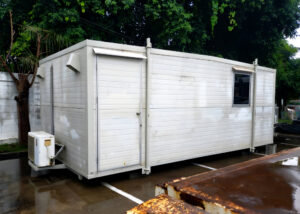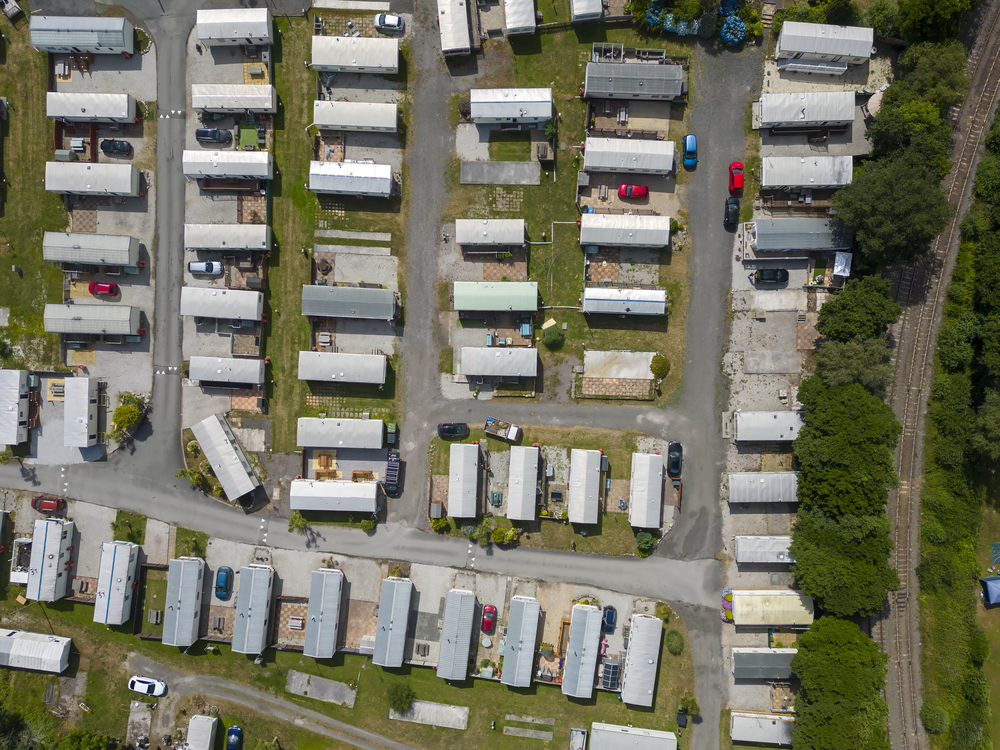In 2017, Tacoma, Washington, declared an emergency. The city’s growing unhoused population was becoming more and more unsustainable, with dozens of sites threatening public health and safety, officials argued, including the “Tacoma Jungle,” an encampment of dozens of tents that had formed in an underpass of State Route 705 downtown. The City Council felt drastic measures and safe shelter for the unhoused were needed.
Part of the solution included new, small fiberglass-and-aluminum shelters from a local company called Pallet, which had started to manufacture 120-square-foot shelters with electric hookups in nearby Everett in 2016. These spartan structures have proven effective, says Caleb Carbone, systems and services manager for Tacoma’s Homeless Strategy. The rate of placement into housing for people who have been unhoused long term tends to be one in ten. For those who stayed in Pallet shelters, he says, the rate inched above one in three.
The emergency still exists, as do these first-generation Pallet shelters. Today, Carbone doesn’t show the tiny homes just to new unhoused residents in need of social services and help. He takes visiting representatives from other cities on tours to learn about the city’s strategy, feeding the interest in setting up such communities across the country.
Tiny homes and shelters, like those from Pallet, are increasingly seen as part of the solution for the country’s ever-growing need for interim shelter and emergency housing, where roughly 327,000 Americans sleep each night. But while the appeal of a budget-conscious, miniature version of housing seems obvious, it’s far from a silver bullet for this crisis.
America’s unhoused population—a record 421,392 in 2022, a 6% rise since 2017—needs temporary housing that can be built more quickly and cheaply than traditional units. Just as a housing-first philosophy has become the ingrained standard approach for homelessness services, a dozen or so companies, such as FactoryOS, Boss, and Plugin House Co., now build, market, and sell tiny home shelters to municipalities searching for solutions. More than 120 villages of these homes now exist, with more in the works.
SHELTER FROM THE STORM OF HOUSING TROUBLE
While other temporary, interim-housing models exist—some cities use RV parking, overnight camping sites, or convert motels and hotels into interim housing—these tiny home villages have caught on in a big way. Austin, Los Angeles, Denver, Tucson, and other cities have recently announced massive expansions and new groundbreakings for such communities. Redondo Beach, south of L.A., has already bought and deployed a few dozen such shelters with plans to double the number of Pallet shelters it uses by this summer. In California, which is short 110,000 shelter beds compared to the size of its unhoused population, late last year Governor Gavin Newsom approved funding to deploy 1,200 tiny homes across the state’s major metros as part of his $1 billion plan to fight homelessness.
This boom has helped Pallet grow significantly. In the past seven years, the firm has built 4,500 shelters that have been distributed across more than 120 sites in the U.S. and Canada. The company is even considering constructing a second factory, which would open next year, rolling out new, larger models later intended to serve families and longer-term housing needs. Pallet, which claims to be the biggest interim-housing producer in the nation, builds 15 shelters a day at its factory, the highest production capacity of any U.S. producers, and can ramp up to 40 per day at max capacity.
Pallet now offers a 70-square-foot Sleeper model for about $18,000, a 120-square foot Sleeper model for $22,000, and a larger EnSuite unit with a bathroom for $48,000; all get shipped in panelized format and are assembled on-site. A Sleeper can be put together in an hour.
Cities and counties make up roughly 80% of the firm’s customer base. Living inside shelters like these can both chafe at some resident’s sense of independence (there are typically rules about guests and curfew, shared bathroom facilities, and an inability to cook anything that requires more than a toaster or microwave), but also offer a place of solitude, quiet, and self-expression, despite the minimal decor inside spartan walls.

THE CHALLENGES OF TEMPORARY TINY SHELTERS
Cost is always going to be front and center in city budget discussions about these solutions.
Permanent, affordable housing is the ultimate solution, Pallet founder and CEO Amy King firmly believes, but since the nation can’t build its way out of the current crisis, she argues that cities need to invest in shelters to stabilize and save lives now.
“A lot of communities want their streets to be cleaned up and available to everyone again, and that’s a reasonable ask,” she says. “This is a tough conversation, because everybody wants the same outcome. We just don’t have the resources to provide that outcome.”
But the proliferation of these solutions says a lot about the nature of the homelessness emergency, the lack of accessible and affordable housing, and what happens when temporary fixes become what some see as too permanent of a solution. Some frustrated leaders have spoken of creating large shelters to house people. In San Diego, Mayor Todd Gloria’s vision of converting vacant industrial space into a 1,000-bed shelter as an emergency measure to confront rising homelessness speaks to the frustration that’s causing these ideas to be entertained. But even as more tiny home shelters get rolled out, the housing shortage continues to impact more Americans.
Some providers not only point to effectiveness but also economics: The long-term costs of what gets billed as temporary shelter could leave cities with unfunded operational expenses, when they still need to spend extensively to build more permanent housing. Jennifer Loving is CEO of Destination Home, a public-private partnership focused on ending homelessness in Santa Clara County, California, that has operated tiny shelters across more than a dozen sites in the state, including San Jose. She found that just a quarter of those who used these tiny homes ended up in permanent housing, and fears increased interest in investment in temporary solutions can divert resources from the real solution.
“Imagine if you have cancer, and the treatment is chemotherapy but I tell you there’s not enough chemo to go around, so you’re going to have to wait, and I’m gonna give you some aspirin,” Loving says. “That’s cool, but you need the treatment. There’s nothing wrong with doing a better job of keeping people in more dignified housing options. But if we’re not making sure that we’re focused on permanent housing, this is an intervention that will be filled up in a minute.”
THE PANDEMIC PLACES ADDITIONAL PRESSURE ON HOUSING
Temporary shelters and tiny home solutions to homelessness became much more prevalent during the COVID-19 pandemic. The older model for temporary shelter, typically a large, shared indoor space, called a congregate shelter, was found unfit for health reasons. There were also long-standing concerns about congregate shelters’ safety, about violence, abuse, and the prospect of splitting up couples and families.
Smaller, individual shelters offered space for health, social, and personal improvement, a waystation on the journey to permanent housing and a better life. At the same time, many civic and business leaders became more concerned about the cost of homelessness. The swell of encampments during the pandemic led to frustration and a willingness to embrace new solutions.
One of the largest proponents was Elizabeth Funk, a San Francisco-based investor and tech exec who began working with business leaders and eventually formed Dignity Moves, which helps construct and deploy tiny home villages at scale. Funk believes cities can build their way out of the problem, and her group aims to show the cost benefit of the interim-housing approach and sell cities on the idea. She argues that cities should look to tap philanthropy for $50,000 tiny homes.
“The streets can’t be the waiting room for permanent supportive housing,” says Ken Craft, founder and CEO of Hope the Mission, an inclusive, faith-based nonprofit that runs roughly eight tiny home shelters with 1,000 units across Southern California. He’s found that unhoused residents of these shelters feel safer, more dignified, and have a better chance of avoiding drugs and violence. It’s a much better waiting room, but still one that’s backed up. Craft says that while most interim housing is meant to last three to six months, residents in Hope the Mission shelters often spend a year or more there.
AN EXPENSIVE SOLUTION
The challenge with the growth of these shelters, and the central question about their use, comes down to the final goals and finances. Cities need to figure out how to deploy them in a manner that creates a suitably rapid and well-organized path to permanent housing, and in doing so not strain municipal resources or take funding away from the end goal of permanent housing. Pallet data, which is aggregated from service providers, suggests that 60% of those who enter these sites end up in permanent housing or reunited with families. Trials of Pallet shelters in Vancouver, Washington, in 2021 found that of the 46 served, who stayed an average 130 days, 14 transitioned into permanent housing and 11 secured employment.
“Economically, you’ve got to have interim housing,” says Funk, who makes the case that temporary shelters make sense when the cost of permanent housing has ballooned. Traditional supportive housing, in the form of multifamily units designated for short-term stays, costs $700,000 per unit on average to build in California—even more in Los Angeles and San Francisco—and there’s simply too much pushback, too many regulatory and construction delays, and not enough land, as previous efforts have shown, to build our way out of the problem in the traditional sense.
“It’s fiscally responsible and humane,” Funk says of the tiny homes. “It’s not very expensive and the payoff is huge; those resources that we’re spending on emergency rooms and police, and picking up feces and needles, can now be spent on other productive things like permanent housing.”
Some housing advocates see support for these shelters as a political strategy, as much as it is a housing strategy. Tiny homes can become an expensive panacea.
“Housing and shelter are distinct resources that should not be conflated, and tiny homes have muddied that conversation,” says Alex Visotzky, senior California policy fellow at the National Alliance to End Homelessness. “Ultimately, permanent housing is what ends somebody’s homelessness. We do view with some concern when communities see tiny homes as a solution.”
Tiny homes should be thought of as a tool, Visotzky says. Some communities and organizations use them well, such as the Union Station Homeless Services village in the Eagle Rock neighborhood of L.A., and follow a formula for making them work: robust staffing, a level of participant choice about the rules governing the community, and easy access to amenities like restrooms and public transit. Pallet, for instance, has its own set of five dignity standards, including hygiene and transit access, and won’t sell to clients who can’t meet those requirements.
More often, Visotzky sees communities struggle with adding both tiny homes and funding the staffing and resources that make these shelters springboards into permanent housing (cities often support both the service organizers and providers of interim housing and support services while also helping fund the creation of more permanent housing).
In these imperfect situations, he says, the majority of exits are either to an unknown destination or back to street homelessness—not to permanent housing.
“It’s one thing to settle for tiny homes, if we didn’t know how to end homelessness,” Visotzky says. “But we know very well what ends homelessness. I think we’ve just been a little too paltry in our investments.”
THE CASE FOR LONGER-TERM HOUSING
Traditional wisdom suggests that tiny homes, for their faults and potential misuse, still offer a cheap and quick solution. But the costs may not be as straightforward as many suggest. Permanent affordable housing will likely be slower. But many providers are starting to argue that the price gap between tiny home shelters and permanent housing isn’t exactly what it’s made out to be.
First, despite the lower sticker price, tiny home shelters still have significant operational costs. And those costs, especially as villages get set up rapidly, aren’t often covered by regular budget expenditures. Operational costs for the Pallet shelters in Tacoma, for instance, come out of the city’s general fund. Craft says finding funding to cover Hope the Mission villages “takes some magic every year” to cobble together funds from city and county governments, since operations spending isn’t fully funded.
“The fact is, tiny home operation and services costs are ongoing,” says Ray Bramson, chief operating officer of Destination Home. “There’s an expectation that permanent housing will last 50-plus years. In the course of that time, you’d have to reinvest in shelters three or four times because they weren’t meant for long-term habitation.”
The high costs of permanent housing do make more sense in that context. But the often incredulous per-unit capital costs also get split up among numerous sources that don’t dip into city coffers. Federal Low-Income Housing Tax Credits and numerous grants and funding streams from different investors help fund construction. And affordable housing remains a recognized, durable asset that generates income and can be refinanced, sold, traded, or take on debt for repairs. Even better, with housing voucher payments, there’s an operational, federally funded program to pay for ongoing maintenance and upkeep, in addition to rent.
If you combine federal and state funding and private debt that can be leveraged for permanent affordable housing, the overall local public subsidy for housing units that cost $700,000 in total actually gets closer to $100,000 per unit, a lot closer to the cost of a tiny home shelter, says David Low, communications director at Destination Home. San Jose’s average subsidy is $150,000 per unit.
Temporary shelters, on the other hand, lack operational and funding support, will degrade in value, aren’t traditional assets, and require ongoing maintenance without voucher payments. San Jose’s city manager estimates that after adding a number of tiny homes to its shelter system, the city will need to pay $70 million per year for shelter operations going forward, a cost that currently doesn’t have a specific revenue or payment stream in the city budget.
“Some people are starting to acknowledge these ongoing costs creates pressure for cities and service providers to reduce the level of services, which is concerning,” Low says, noting that he’s particularly worried about these ongoing costs when expansion of tiny homes is being proposed quickly and at scale.
WE PROVIDE THE TOOLS
Getting someone into permanent housing doesn’t necessarily require new buildings. Other programs, including rental subsidies, case management, emergency eviction aid, and guaranteed income programs can also keep people in permanent homes. Visotzky argues that a well-tailored rental subsidy program with supportive services can cost as much or less than maintaining a tiny home village—and deliver better results. A significant study of California’s houseless population found that most unhoused people felt a $300- to $500-per-month subsidy would have kept them sheltered, and a no-strings-attached subsidy program in Silicon Valley has found that roughly $6,000 to $7,000 per household, spread over four months, can prevent evictions and potential homelessness.
King argues that while Pallet isn’t directly providing the social workers and support staff, it’s creating a space for them to operate. One of the Pallet projects is set up in a hospital parking lot in Boston, where the Commonwealth Care Alliance and Eliot Community Human Service team can provide 24-hour healthcare and temporary shelter. In New Jersey, there’s a Pallet shelter site set up outside a prison that provides former inmates with temporary shelter and support before they transition to their home community.
“The magic that happens at Pallet sites is done by the service providers,” King says. “We provide the tool; we do not rehabilitate people just through the provision of a shelter.”
Pallet, the interim-house company, was initially conceived as one part of a collective of companies aimed at providing housing. It was joined by two other companies, Square Peg, which would build permanent homes, and Weld, which would provide social services. After all three launched, Pallet was the one that caught on, so the other services were spun off or wound down.
Pallet seems poised to continue to take off, as municipalities continue to embrace the model. King says the company is talking to a lot of communities about stockpiling or pre-positioning its shelters for emergencies, which, because they’re panelized, take up less space than modular or fully built Federal Emergency Management Agency trailers. Pallet is also viewing the migrant crisis and international migration as potential domestic and international areas of expansion. Even legal news has sparked interest: The fate of Supreme Court cases around homelessness, which may shift homeless protections, and a law signed by Florida Governor Ron DeSantis in March that banned the unhoused people from camping on city streets, have created more interest and even inbound calls from municipalities.
“It’s a bittersweet thing,” King says in reference to all the incoming business for her company. “We’re grateful to have a lot of job opportunities for people. But certainly, we’re not excited about the fact that the problem is growing to an extent that we are growing in that regard. But yes, we have grown extensively.”

